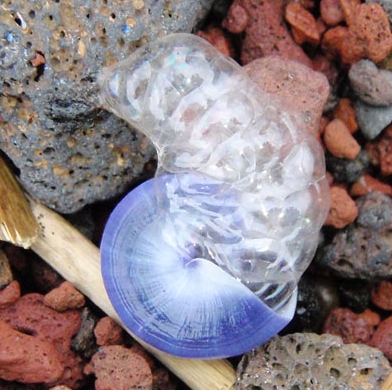Sunday, April 18, 2010
Sunday Spinelessness - kleptomaniac octopuses and other amazing mollsucs
Stuff.co.nz has a very cool video that was shot from an underwater video camera as it was grabbed by a lurking octopus:
It's amazing to see the octopus's suckered arm shoot out from a reef and grab at the diver, and to see the octopus enjoying a ride on the blunt side of the diver's spear a little later. But for me, as someone who spends his days studying landsnails, it really set me to thinking about the remarkable diversity of form in the phylum Mollusca.
This series has focused on the other great animal phylum, the Arthropoda, and with good reason. Most animals are arthropods. But that group has achieved its dominance by finding a good basic body plan, an exoskeleton and set of jointed limbs, and making a million variations on the theme. By comparison, evolution has molded the soft mollusc body into thousands of forms. Cephalopods like the Octopus maorum featured above are perhaps the most amazing result. They are intelligent, free swimming predators with three hearts and amazing powers of disguise. Which is why I still find it amazing that cephalopods likely evolved from snail-like ancestors.
I really shouldn't be so surprised. There are plenty of snails around today that cast off that group's reputation for a sedentary lifestyle to swim the seas as predators. One example that might be familiar to readers is the violet snail, Janthina sp., whose pretty purple shells are occasionally washed up on New Zealand beaches. The violet snail can't actively swim as an adult, instead it builds a raft of air bubbles trapped in chitin and floats on the surface where it eats swimming jellyfish.


The violet snails are pretty cool, but they aren't a massive divergence from the gastropod body plan. The snails that used to be known as pteropods are much more radically adapted to swimming. These snails are now recognised as two distinct groups, the "sea butterflies" (Thecosomata) which have retained their shells and the "sea angels" (Gymnosomata) which have lost them. As you might have guessed form their names, both of these groups have developed "wings" (derived from the foot muscle) they use to flap their way through the water column.


There is one group of swimming snails that are even more stunning than the sea angels and the sea butterflies. The nudibranchs (commonly referred to as "sea slugs") are pretty weird bunch of gastropods to start with. They come in a bewildering range of colours and some of them are even solar powered and there are a couple of species that have become adapted to swimming, or at least floating, on the ocean surface. Two species from the family Glaucidae, Glaucus atlanticus and Glaucilla marginata have developed swim bladders and long limb like protuberances that make the look, to me at least, a little like fish:

Glaucus atlanticus licensed CC 2.0 by flickr user tarotastic
Labels: cephalopods, environment and ecology, molluscs, octopus, photos, sci-blogs, snails, sunday spinelessness


